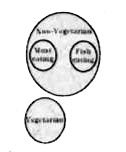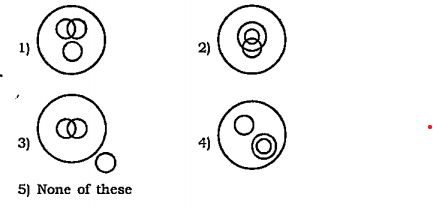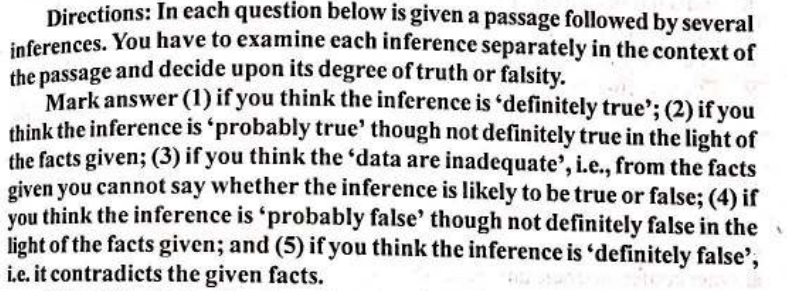In a feast organised in connection with a marriage, some of the participants were vegetarians, some others were non-vegetarians. Another group was of non vegetarians not eating meat and yet another group of people eating meat but not fish. Which of the following represents this statistics?

The correct Answer is:B
The correct representation for the above information is as such

Topper's Solved these Questions
- BOOK - KIRAN PUBLICATIONCHAPTER - LOGICAL VENN - DIAGRAMEXERCISE - TYPE- II159videos
LOGICAL VENN - DIAGRAM
- BOOK - KIRAN PUBLICATIONCHAPTER - FINDING THE MISSING NUMBEREXERCISE - TYPE - II380videos
FINDING THE MISSING NUMBER
- BOOK - KIRAN PUBLICATIONCHAPTER - MIRROR & WATER IMAGES EXERCISE - TYPE -II9videos
MIRROR & WATER IMAGES
Similar Questions
In a dinner party both fish and meat were served. Some took only fish and some only meat. There were some vegetarians who did not accept either. The rest accepted both fish and meat. Which of the following Venn-diagrams correctly this situation ?
 View Solution
View Solution
Even after allowing for the inclusion of the unavoidable chillies, on the whole the Indian diet seems to be more protective than carcinogenic. The per capita fat intake is only 14-20 g daily, far below even the per capita consumption of 35 g daily recommended by the Indian Council of Medical Research. In practice, most of the population is essentially vegetarian, as even the so-called non-vegetarians eat meat only once or twice a week, meat being expensive. The incidence of cancer in India, with the age standardised rate of 115 per 100,000, is one of the lowest in Asia, and is only about one-third incidence in the West. The Indian diet may be one of the factors responsible.
Consumption of meat would go up if meat becomes cheaper.View Solution
Knowledge Check
- Question 1 - Select One
In a hotel, 60% had vegetarian lunch while 30% had non vegetarian lunch and 15% had both types of lunch. If 96 people were present, how many did not eat either type of lunch ?
A20B24C26D28 - Question 2 - Select One
Long ago men spent most of their time looking for food. They ate anything they could find. Some lived mostly on plants. They ate the fruit, stems, and leaves of some plants and the roots of others. When food was scarce, they ate the bark of trees. If they were lucky, they would find a bird's nest with eggs. People who lived near the water ate fish or anything that washed ashore, even rotten whales. Some people also ate insects and small animals like lizards that were easy to kill.
Later, men learned to make weapons. With weapons, they could kill larger animals for meat. These early people had big appetites. If they killed an animal, they would drink the blood, eat the meat, and chew the bones. When they finished the meal, there was nothing left.
At first men wandered from place to place to find their food. But when they began to grow plants, they stayed in one place and ate what they could grow. They tamed animals, trained them to work, and killed them for meat, Life was a little better then, but there was still not much variety in their meals. Day after day people ate the same food,
Gradually men began to travel greater distances. The explorers who sailed unknown seas found new lands. And in these lands they found new food and spices and took them back home.
The Portuguese who sailed around the stormy Cape of Good Hope to reach China took back "Chinese apples", the fruit we call oranges today. Later, Portuguese colonists carried orange seeds to Brazil. From Brazil oranges were brought to California, the first place to grow oranges in the United States. Peaches and melons also came from China. So did a new drink, tea.
Which of the following titles best expresses the main idea of the passage ?AEat Healthy FoodBThe Search for FoodCThe Foods We EatDGreat Food Regions of the World - Question 3 - Select One
In a hotel 60% had vegetarian lunch while 30% had non vegetarian ,lunch and 15% had both types of lunch. If 96 people were present how many did not eat either type of lunch? 20 b. 24 c. 26 d. 28
A20B24C26D28

Even after allowing for the inclusion of the unavoidable chillies, on the whole the Indian diet seems to be more protective than carcinogenic. The per capita fat intake is only 14-20 g daily, far below even the per capita consumption of 35 g daily recommended by the Indian Council of Medical Research. In practice, most of the population is essentially vegetarian, as even the so-called non-vegetarians eat meat only once or twice a week, meat being expensive. The incidence of cancer in India, with the age standardised rate of 115 per 100,000, is one of the lowest in Asia, and is only about one-third incidence in the West. The Indian diet may be one of the factors responsible.
The percentage of people suffering from cancer is the lowest in the case of India.View SolutionEven after allowing for the inclusion of the unavoidable chillies, on the whole the Indian diet seems to be more protective than carcinogenic. The per capita fat intake is only 14-20 g daily, far below even the per capita consumption of 35 g daily recommended by the Indian Council of Medical Research. In practice, most of the population is essentially vegetarian, as even the so-called non-vegetarians eat meat only once or twice a week, meat being expensive. The incidence of cancer in India, with the age standardised rate of 115 per 100,000, is one of the lowest in Asia, and is only about one-third incidence in the West. The Indian diet may be one of the factors responsible.
Indians are likely to be more overweight than others.View SolutionEven after allowing for the inclusion of the unavoidable chillies, on the whole the Indian diet seems to be more protective than carcinogenic. The per capita fat intake is only 14-20 g daily, far below even the per capita consumption of 35 g daily recommended by the Indian Council of Medical Research. In practice, most of the population is essentially vegetarian, as even the so-called non-vegetarians eat meat only once or twice a week, meat being expensive. The incidence of cancer in India, with the age standardised rate of 115 per 100,000, is one of the lowest in Asia, and is only about one-third incidence in the West. The Indian diet may be one of the factors responsible.
Indian diet is the main reason behind the low incidence of cancer.View SolutionEven after allowing for the inclusion of the unavoidable chillies, on the whole the Indian diet seems to be more protective than carcinogenic. The per capita fat intake is only 14-20 g daily, far below even the per capita consumption of 35 g daily recommended by the Indian Council of Medical Research. In practice, most of the population is essentially vegetarian, as even the so-called non-vegetarians eat meat only once or twice a week, meat being expensive. The incidence of cancer in India, with the age standardised rate of 115 per 100,000, is one of the lowest in Asia, and is only about one-third incidence in the West. The Indian diet may be one of the factors responsible.
Chillies make a diet carcinogenic.View SolutionLong ago men spent most of their time looking for food. They ate anything they could find. Some lived mostly on plants. They ate the fruit, stems, and leaves of some plants and the roots of others. When food was scarce, they ate the bark of trees. If they were lucky, they would find a bird's nest with eggs. People who lived near the water ate fish or anything that washed ashore, even rotten whales. Some people also ate insects and small animals like lizards that were easy to kill.
Later, men learned to make weapons. With weapons, they could kill larger animals for meat. These early people had big appetites. If they killed an animal, they would drink the blood, eat the meat, and chew the bones. When they finished the meal, there was nothing left.
At first men wandered from place to place to find their food. But when they began to grow plants, they stayed in one place and ate what they could grow. They tamed animals, trained them to work, and killed them for meat, Life was a little better then, but there was still not much variety in their meals. Day after day people ate the same food,
Gradually men began to travel greater distances. The explorers who sailed unknown seas found new lands. And in these lands they found new food and spices and took them back home.
The Portuguese who sailed around the stormy Cape of Good Hope to reach China took back "Chinese apples", the fruit we call oranges today. Later, Portuguese colonists carried orange seeds to Brazil. From Brazil oranges were brought to California, the first place to grow oranges in the United States. Peaches and melons also came from China. So did a new drink, tea.
Which of the following statements is not true?View Solution

